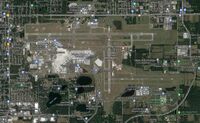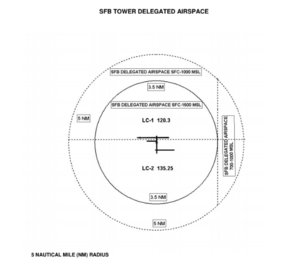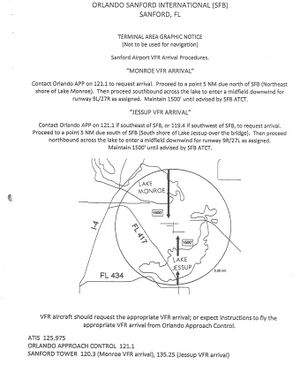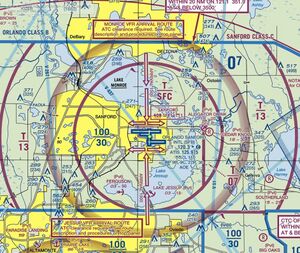Sanford Orlando ATCT
Table of Updates
| Date | Revision | Items Revised |
|---|---|---|
| 14 April 2023 | A | IFR releases required for all departures out of SFB. |
| 7 June 2023 | B | Added PDC Not Authorized, Removal LOAs, Added LUAW Section, Requirement of Scratchpad Entries, Organization |
| 8 July 2023 | C | Updated DTAs |
| 22 October 2023 | D | Updated Tower Airspace and VFR Procedures |
Area Information
| ICAO Code | Airport Name | Airspace | IFR Beacon Codes | VFR Beacon Codes |
|---|---|---|---|---|
| KSFB | Sanford/Orlando International Airport | C | 0701-0777 | 0701-0777 |
| Purpose This document prescribes the procedures to be utilized for providing air traffic control services at the Sanford/Orlando Air Traffic Control Tower (SFB ATCT). The procedures described herein are supplemental to the Jacksonville ARTCC Facility Operating Guidelines and FAA Order JO 7110.65, as well as any published FAA guidelines or procedures. Distribution |
Operational Positions
| Position | Radio Name | Callsign | Relief Callsign | Symbol | Frequency |
|---|---|---|---|---|---|
| Clearance Delivery | Sanford Clearance Delivery | SFB_DEL | SFB_1_DEL | 4SD | 123.975 |
| Ground | Sanford Ground | SFB_GND | SFB_1_GND | 4SG | 121.350 |
| North Tower | Sanford Tower | SFB_N_TWR | SFB_1N_TWR | 4NT | 120.300 |
| South Tower | Sanford Tower | SFB_S_TWR | SFB_1S_TWR | 4ST | 135.250 |
Sector in Red is the primary sector.
Clearance Delivery
Clearance Delivery Responsibilities
The Clearance Delivery Controller Must:
- Formulate and issue all IFR clearances to aircraft departing this field.
- Review proposed flight plan information for accuracy and amend routings and altitudes, as necessary, in accordance with this SOP.
- Enter amendments to flight plans into the controller client as required and advise the pilot what those amendments are.
- Issue clearances or route changes to aircraft, as required complying with traffic management initiatives and/or weather avoidance.
- Forward and await a response on all non-standard routing requests to the affected facilities.
- During Events: Do not change routes or proposal times for aircraft participating in Traffic Management programs without prior coordination with the controller in charge.
Pre-Departure Clearances
IFR Departures
Planned/Amended Routing
All Aircraft shall be cleared via the SFB# SID with the appropriate F11 DTA.
Enter the DTA instead of the departure in the routing.
i.e. ATLAS DDANY JIPOD CUUDA2
| Direction | DTA | Associated Fixes |
|---|---|---|
| North | WORMS | TAY, CRG, OMN, SGJ, SSI |
| West | CAMAN | CTY, SZW, OCF, KNOST, BULZI, HEVVN, PATOY, BRUTS, SAAIL, GEMLY |
| Southwest | FSHUN | RSW, SRQ, CYY, FSHUN |
| Southwest | KNEED | PIE, MCF, LAL |
| Southeast | ATLAS | MLB, TRV, PBI, FLL, DDANY |
| Southeast | TPSTR | TRV, PBI, FLL, MLB, PHK |
| Northwest | VIZTA | TAY, SZW, OCF, BULZI, HEVVN |
Assigned Altitudes
Aircraft shall be instructed to maintain 2,000 feet and to expect their cruise altitude (if higher) ten minutes after departure.
Departure Frequency
The Primary Departure Frequency is MCO_E_APP on 124.800.
Squawk Assignment
All IFR Squawk codes will be auto-assigned by the controller client.
It should assign a code between 0701-0777. Controllers shall not change the auto-assigned code if a code between 0701-0777 is not assigned.
VFR Departures
Clearance
VFR Aircraft do not need explicit clearance to enter or exit the airspace.
All VFR remaining in the pattern will require coordination with the tower and will be directed to contact when ready for taxi.
Assigned Altitudes
Jet: VFR aircraft shall be instructed to maintain VFR at or below 1,500.
Turboprops: VFR aircraft shall be instructed to maintain VFR at or below 1,500.
Props: VFR aircraft shall be instructed to maintain VFR at or below 1,500.
Departure Frequency
Aircraft not remaining in the pattern shall be given the Departure Frequency is MCO_E_APP on 124.800.
Aircraft remaining in the pattern shall not be given a departure frequency.
Squawk Assignment
VFR Squawk codes shall be assigned by the controller client using the assign squawk feature in their controller client.
Ground
General Information
Ground Control Responsibilities
The Ground Controller is responsible for the movement of vehicles and aircraft on the airport movement areas except for the active runway(s)
ATIS
Ground control shall confirm all pilots have the current ATIS code PRIOR to commencing taxi to the active runway. This can be achieved by requesting the pilot "state the current ATIS code". The ATIS is the responsibility of the tower controller.
Active Runway Operations
Except for runway crossings, Ground Control must transfer communication to Local Control if a vehicle/aircraft is to operate on a runway. Coordination for all runway crossings must be accomplished by requesting permission from local control by stating "(Number of Aircraft) to cross Runway (#) at Taxiway (Letter). Once approved and crossing has been granted and the crossing has been observed, ground control must state to local control "Runway (#) crossing complete"
Intersection Departures
Ground Control must advise local control of all intersection departures verbally.
Opposite Direction Departures
Ground Control must coordinate and obtain approval from Local Control, prior to taxiing an aircraft to a runway for an opposite-direction departure.
Pushback and Startup
Push back into a controlled area: Aircraft shall be instructed: "Push and Start Approved, tail facing (direction)." The direction should keep the aircraft pointed in the direction the aircraft will taxi.
Push back will not enter a controlled area: Aircraft shall be instructed: "Push and start at pilot's discretion."
Runway Assignments
All jet/turboprop traffic will utilize 9L/27R Except for air carriers, verbally coordinate with LC1/LC2 prior to taxiing aircraft to the departure end of Runway 9L/27R, Runway 27C, Runway 9R, and Runway 18, or an intersection other than a designated departure intersection. Runway 9C departures must be positioned on Taxiway L unless otherwise coordinated with LC2. Any use of Taxiway K1 requires LC2 approval, except for aircraft exiting Runway 27C. Any use of Taxiway C between Runway 18/36 and the ARFF station requires LC2 Approval.
Taxi Operations
Aircraft shall be taxied to their location via the short distance.
Transfer of Communication
Departing aircraft shall be instructed to contact the local control frequency upon or slightly before holding short the runway for departure. Local control has the option to have the pilot "monitor" the frequency. If a pilot is going to monitor, ground control must send a private message via the controller client of the aircraft with their callsign and runway. </tab> </tabs>
Tower
Active Runway Selection
The active runway shall be determined based on wind and known
factors that may affect the safety of takeoff/landing operations.
East configuration is designated as the calm wind runway.
- East Configuration: Runway 9L, 9C, 9R
- West Configuration: Runway 27L, 27C, 27R
Area of responsibility
LC1 and LC2’s areas of responsibility are defined in the diagram below.
Arrival Procedures
LC shall be responsible for separation of all arrival aircraft that have
been handed off by TRACON from all departing aircraft still under LC
jurisdiction
Practice Instrument Approaches: Issue special instructions as verbally coordinated with the
TRACON. Practice Instrument Approaches shall assign runway heading and maintain 2,000 feet. Departure frequency as assigned by approach control.
LC shall NOT change the approach sequence without coordination. Communication transfer must be completed prior to five nautical miles
from the runway.
Automatic Terminal Information Service
LC shall manage the ATIS
The ATIS shall be on 123.975
Departure Releases
Departure releases must be obtained via F11 TRACON.
Departure Procedures
LC will provide separation for aircraft in the LC airspace.
LC shall provide initial radar separation between successive departures.
| DTA | Runway | Piston | Jet/Turboprops |
|---|---|---|---|
| WORMS | 9L | 050 | 080 |
| WORMS | 9C/9R | 050 | N/A |
| WORMS | 27R | 310 | 280 |
| WORMS | 27C/27L | 310 | N/A |
| All Other DTAs Except WORMS | 9L | 110 | 080 |
| All Other DTAs Except WORMS | 9C/9R | 110 | N/A |
| All Other DTAs Except WORMS | 27R | 260 | 280 |
| All Other DTAs Except WORMS | 27C/27L | 260 | N/A |
Go Around/ Unplanned Missed Approaches
LC shall assign IFR aircraft runway heading and 2,000 feet
LC must verbally coordinate with departure prior to frequency change.
Land and Hold Short
LAHSO operations are authorized at SFB for during daytime VFR conditions only for runway 9L and 27R only.
The Controller shall announce to the pilot who requested it the available landing distance.
Line Up and Wait
Line up and wait is authorized at this field only in VMC Conditions. LUAW departures from an intersection are only authorized between sunrise and sunset.
Visual Tower
Sanford Orlando ATCT is a visual/VFR tower and shall not initiate or accept any radar handoffs and shall not initiate control/start track on any target.
VFR Procedures
SFB is a busy pilot training airport and utilizes prearranged VFR procedures to reduce controller workload. These 2 procedures are lake landmarks that arrive to the airport from the North (Monroe Arrival) and South (Jessup Arrival). Pilots that are familiar will likely request these procedures. F11 will clear the aircraft for the requested arrival and transfer communications. The aircraft should be at 1500 ft to the initiation of the downwind and Local shall advise the pilot to descend to pattern altitude. (See Diagrams)



